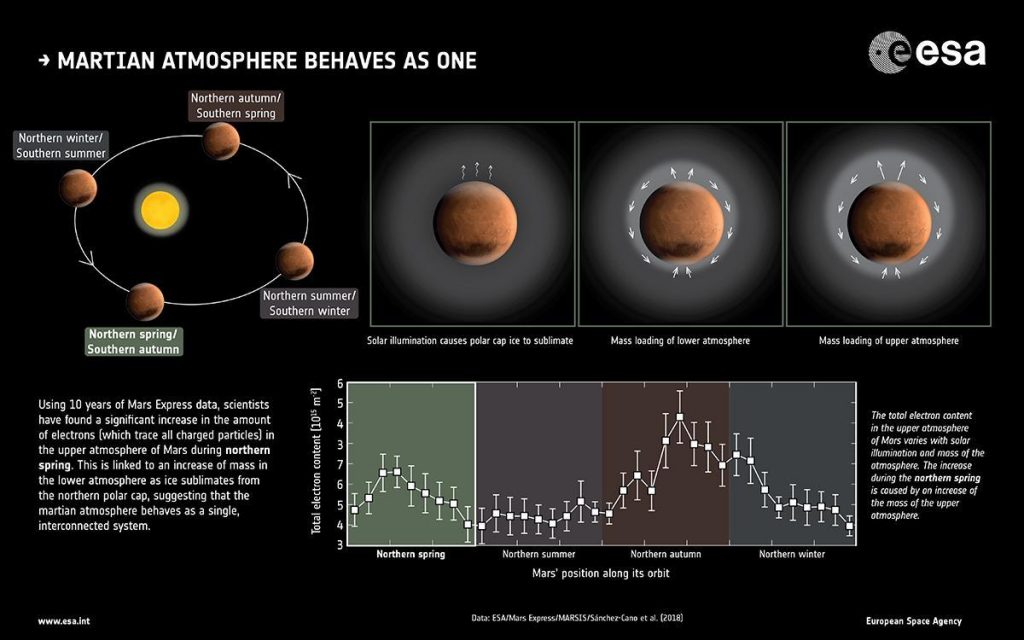18 July 2018
Martian atmosphere behaves as one
Posted by Lauren Lipuma

This artist’s concept shows the three segments of MARSIS, the radar instrument on the Mars Express spacecraft.
Image credit: NASA/JPL/Caltech.
By the European Space Agency
New research using a decade of data from the European Space Agency’s Mars Express mission has found clear signs of the complex Martian atmosphere acting as a single, interconnected system, with processes occurring at low and mid levels significantly affecting those seen higher up.
Understanding the Martian atmosphere is a key topic in planetary science, from its current status to its past history. Mars’ atmosphere continuously leaks out to space, and is a crucial factor in the planet’s past, present, and future habitability – or lack of it. The planet has lost the majority of its once much denser and wetter atmosphere, causing it to evolve into the dry, arid world we see today.
However, the tenuous atmosphere Mars has retained remains complex, and scientists are working to understand if and how the processes within it are connected over space and time.
A new study based on 10 years of data from the radar instrument on Mars Express spacecraft now offers clear evidence of a sought-after link between the upper and lower atmospheres of the planet. While best known for probing the interior of Mars via radar sounding, the instrument has also gathered observations of the Martian ionosphere since it began operating in 2005.
“The lower and middle levels of Mars’s atmosphere appear to be coupled to the upper levels: there’s a clear link between them throughout the Martian year,” said Beatriz Sánchez-Cano, a planetary scientist at the University of Leicester in the United Kingdom and lead author of the new study in the Journal of Geophysical Research: Planets, a journal of the American Geophysical Union.
“We found this link by tracking the amount of electrons in the upper atmosphere – a property that has been measured by the MARSIS radar for over a decade across different seasons, areas of Mars, times of day, and more – and correlating it with the atmospheric parameters measured by other instruments on Mars Express,” Sánchez-Cano said.
The amount of charged particles in Mars’s upper atmosphere – at altitudes between 100 and 200 kilometers (60 to 120 miles) – is known to change with season and local time, driven by changes in solar illumination and activity, and, crucially for this study, the varying composition and density of the atmosphere itself. But the scientists found more changes than they were expecting.
“We discovered a surprising and significant increase in the amount of charged particles in the upper atmosphere during springtime in the Northern hemisphere, which is when the mass in the lower atmosphere is growing as ice sublimates from the northern polar cap,” Sánchez-Cano said.
Mars’s polar caps are made up of a mix of water ice and frozen carbon dioxide. Each winter, up to a third of the mass in Mars’s atmosphere condenses to form an icy layer at each of the planet’s poles. Every spring, some of the mass within these caps sublimates to rejoin the atmosphere, and the caps visibly shrink as a result.
“This sublimation process was thought to mostly only affect the lower atmosphere – we didn’t expect to see its effects clearly propagating upwards to higher levels,” said Olivier Witasse, a planetary scientist at the European Space Agency, co-author of the new study and former ESA Project Scientist for the Mars Express mission. “It’s very interesting to find a connection like this.”
The finding suggests that the atmosphere of Mars behaves as a single system.
This could potentially help scientists to understand how Mars’s atmosphere evolves over time – not only with respect to external disturbances such as space weather and the activity of the Sun, but also with respect to Mars’s own strong internal variability and surface processes.
Understanding the complex atmosphere of Mars is one of the key objectives of ESA’s Mars Express mission, which has been operating in orbit around the Red Planet since 2003.
— This post originally appeared as a press release on the ESA website.



 GeoSpace is a blog on Earth and space science, managed by AGU’s Public Information staff. The blog features posts by AGU writers and guest contributors on all sorts of relevant science topics, but with a focus on new research and geo and space sciences-related stories that are currently in the news.
GeoSpace is a blog on Earth and space science, managed by AGU’s Public Information staff. The blog features posts by AGU writers and guest contributors on all sorts of relevant science topics, but with a focus on new research and geo and space sciences-related stories that are currently in the news.